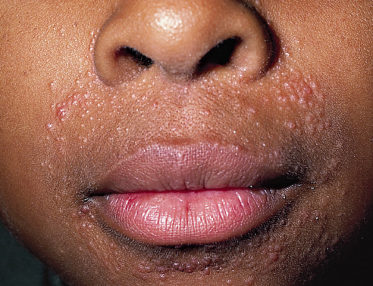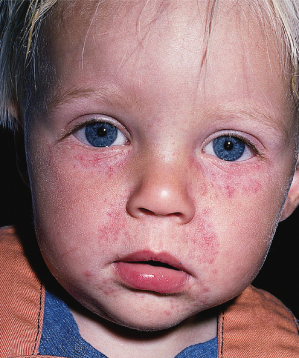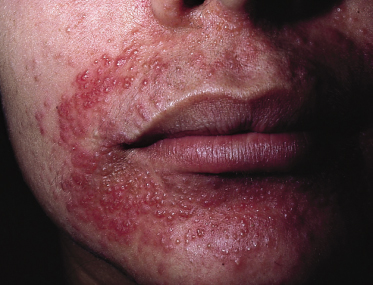Clinical Features.
The name ‘perioral dermatitis’ is really a misnomer, as perinasal and periocular lesions are also commonly present [2,19,20]. Nguyen & Eichenfield reported that while perioral involvement is the most common feature, more than half the cases also involve other periorificial sites [20]. Manders & Lucky [1] noted an incidence of 57% with infraorbital lesions, and suggested that children may have a higher frequency of periocular and perinasal lesions than their adult counterparts (Fig. 38.2). Other reported sites of involvement include the glabella [2], chest [21,22], and vulva [20]. The vermilion border of the lip is typically though not invariably spared (Fig. 38.3). Involvement of the lips and corners of the mouth is more likely to be due to a specific contact allergen [13]. In most cases, small erythematous papules are present superimposed on a background of erythema and scaling. In severe cases, pinpoint vesiculopustular lesions may be evident. A small proportion of patients may experience associated pruritus and, less frequently, burning [20]. In the granulomatous form of perioral dermatitis, lesions are often discrete, small, firm, dome-shaped, flesh-coloured papules without perceptible erythema or scale (Fig. 38.4). Some cases show overlapping clinical features of these two disease variants.
Fig. 38.4 Perioral granulomatous dermatitis.
Reproduced with permission from Frieden et al. 1989 [3], © American Medical Association, 1989.

The granulomatous form of periorificial dermatitis can infrequently present with extensive involvement of extrafacial sites, such as the trunk, extremities and genitals. In one case series of generalized granulomatous periorificial dermatitis, all the patients had typical involvement of periorificial sites and no associated systemic symptoms, and diagnosis was supported by perifollicular granulomatous infiltrate on biopsy and/or response to oral antibiotics in the tetracycline or macrolide family [23].
Prognosis.
The condition generally has a good prognosis, but pinpoint scarring has been reported in a few cases [24]. If left untreated, the condition can wax and wane for months to years, but with treatment generally resolves within a few months. Recurrences may develop after cessation of treatment.
Differential Diagnosis.
The differential diagnosis of perioral dermatitis depends on whether granulomatous lesions are present. When they are absent, the differential diagnosis includes contact dermatitis, atopic dermatitis, acne rosacea, lip licking, Demodex folliculitis [25] and a group of diverse metabolic disorders such as acrodermatitis enteropathica, Shwachman syndrome [26] and biotin deficiency, which can cause periorificial dermatitis. The differential diagnosis of the granulomatous form also includes acne rosacea, as well as sarcoidosis, benign cephalic histiocytosis and granulosis rubra nasi [3]. Demodex folliculitis in particular can have marked clinical overlap. It most commonly occurs in patients receiving chemotherapy for malignancy, but cases due to immunodeficiency have also been reported [25].
Also in the differential diagnosis is lupus miliaris disseminatus faciei (LMDF). Some consider LMDF and granulomatous periorificial dermatitis to be the same entities, as they share clinical and histopathological characteristics. Lupus miliaris disseminatus faciei was thought to differ from granulomatous periorificial dermatitis because the former was defined as having epithelioid cell granulomas with caseation necrosis but in fact, recent reviews have shown that caseous necrosis is a relatively rare finding in LMDF [27].
Stay updated, free articles. Join our Telegram channel

Full access? Get Clinical Tree










